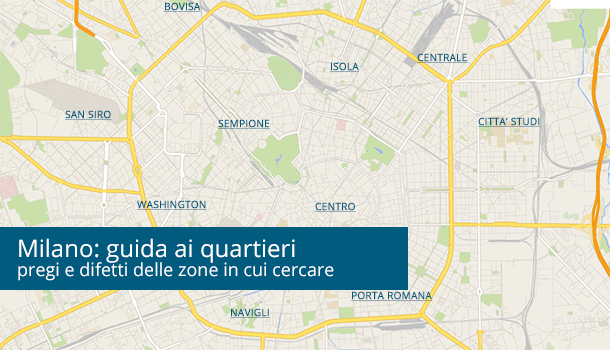The Moral Capital, industrious, lively, European, rich, frenetic, stimulating, active. The only Italian center linked by “an umbilical cord to Europe,” according to historian Renzo De Felice, who added, “Milan represents a tireless incubator of the new that is born in the country.” “The most city in Italy” for Giovanni Verga.
Milan is all this, yes, but it is also a small city: although it is the second largest city in Italy in terms of population, more than 1.3 million, it consists of a relatively small city center, less than 10 km in diameter, a trifle when compared with the mammoth Rome. And the size is its cross and delight: it makes it livable and human-scale, enabled the organization of a precise and extensive urban transportation network, make it possible to move from one end of the city to the other in less time, but at the same time have actually resulted in a highly concentrated housing market and with decidedly high prices: it is in fact The city with the most expensive rents in Italy. And it is a city in constant motion, now overwhelmed by the many works for EXPO 2015, scheduled to begin on May 1, 2015.
Therefore, if you find yourself looking for an apartment or room to rent in Milan, knowing the geographical city and the merits and flaws of the main areas is the necessary starting point. Here, then, is a brief guide to Milan’s major neighborhoods.
Indice contenuto
City Center – Duomo and Brera
The central area of the city, conventionally fixed with the Duomo and the surrounding area for the radius of one kilometer, is the working, cultural and religious center of the city, which “forgets” about the rest of the metropolis: the Galleria Vittorio Emanuele, Teatro della Scala, Palazzo Reale, Sempione Park and the Sforza Castle, and the Brera Art Gallery make magnificent Milan’s Drawing Room, which, however, for the same reasons offers few housing options, all of them and decidedly unaffordable prices. As beautiful as it is, it is an area practically off limits to those with less than a few thousand in their pockets each month.

Washington – San Siro
Elegant and with splendid 19th-century buildings, the Porta Magenta area is one of the city’s most residential and affluent, with some of the city’s best-known shopping streets such as Via Magenta itself, Corso Vercelli, and Via Belfiore. Rental prices here are also very high, and it is moreover an area that sees subway coverage only in the northern part, with the Pagano and Wagner stops.
Even further northwest is the San Siro and then Fiera area, which is slightly more suburban and has lower prices.

Porta Garibaldi – Isola
Isola, which takes its name precisely from its traditional physical isolation from the rest of the city, brought about by the caesura caused by the Porta Garibaldi station, is a neighborhood with a very strong identity, basically the only one in Milan where it is possible to “live the street” walking through the streets and small squares that characterize it: in recent years it has exerted a very strong appeal for students and young couples, artists and designers who populate the city, making it their neighborhood of choice. Accessible on foot from the Porta Garibaldi train station (also a stop on Metro Line2), where, on the contrary, a clear transformation is underway, with the Porta Nuova skyscraper project and the new Gae Aulenti square. Prices are rising rapidly, but still not prohibitive if you have some patience to look.

Bovisa
A historic working-class neighborhood with a blue-collar matrix, Bovisa is well worth a mention because it is perhaps the area that has seen the strongest residential development in the past decade, largely due to the presence of the branch office of the Polytechnic University of Milan, on the Via Durando campus, which houses the Schools of Architecture and Design, and on the Via La Masa campus, where some courses of the School of Industrial and Information Engineering are based. Also worth noting is the presence of Triennale Bovisa, the new headquarters of the Milan Triennale, which has been open since 2006.
The area is precisely experiencing a gradual residential rediscovery that shows no sign of abating, resulting in a gradual increase in rental prices, which are still on average lower than in the other areas listed in this article.
Central – Città Studi
A slight forcing allows us to include in a single area the area from Central Station to Piazzale Loreto, passing through Corso Buenos Aires to then Città Studi, a neighborhood in the northeastern part of the city where the Polytechnic University of Milan and the Five science faculties of the University of Milan.
This is one of the most popular areas of the city, where rental prices are still relatively low, the availability of houses and apartments quite high, and consequently one of the areas of choice for out-of-town students staying in Milan. Well connected with the rest of the city, there are stops of the various Metro Lines (Line 1: Loreto, Lima, Line 2: Centrale, Loreto, Piola, Lambrate, Line 3:Centrale).
Continuing toward the center of the city, one encounters the beautiful area of Porta Venezia and Palestro, where there are marvelous nineteenth-century palaces and prices go up–quickly–as a result.

Roman Gate
Another area of great appeal is Porta Romana, an elegant neighborhood where 19th-century buildings alternate with more modern constructions and is full of restaurants, clubs and attractions, especially in the Viale Montenero area, home to some of the city’s busiest hangouts.
Very close to the center, the area is home to the prestigious Luigi Bocconi Commercial University and is consequently a coveted area for all the students who attend it.
The area around Porta Genova station is definitely one of the most desirable and lively in the city, while still maintaining affordable prices in some of its corners, especially going out to the outer-city. At the intersection of the two of the city’s typical canals, the Naviglio Grande and the Naviglio Pavese, opens up a neighborhood rich in points of interest and above all very much alive, with an excellent balance between tranquility and opportunities for socializing. Typical of this area, if one is lucky enough to find one at a humane price, are the railing houses: buildings a few stories high, with interior courtyards overlooked by balconies with railings through which the various apartments are accessed.
As mentioned, the area is home to the Porta Genova train station, which is also one of the stops on the MM2 (Green Line) subway and is well connected to the rest of the city by tram lines 2, 9 and 19. Further south are then the Romolo and Famagosta subway stops: just a stone’s throw away from Romolo is the headquarters of IULM University.

Ti potrebbe interessare anche:

Pubblicato il 19-05-2023 11:05:53

Pubblicato il 13-05-2023 15:34:33
Pubblicato il 09-05-2023 14:39:52

Pubblicato il 09-01-2023 10:14:51

Pubblicato il 05-01-2023 13:04:04
